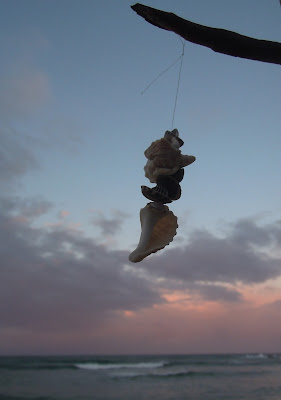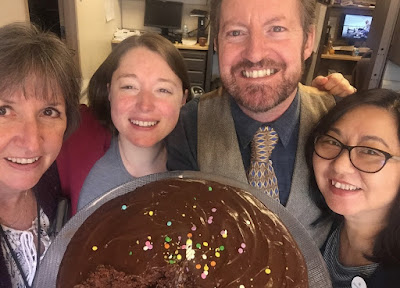Today is Halloween, which here in the U.S., has become an abhorrent commercial spectacle. This despite the fact that the day has roots in the Catholic celebrations of November 1, “All Hollows' Day” (or “All Saints' Day”) and November 2, “All Souls' Day.”
Deeper still . . . elements of both these Christian feasts are grounded in a pagan holy day, the ancient Gaelic festival of Samhain (pronounced sow-in), which was the eve of the Gaelic new year. It was the time when it was believed the veil between this world and the next was at its thinnest, and people and spirits could “cross over,” could pass back and forth between the two worlds. Huge bonfires were lit on hilltops – some say to frighten away evil spirits; others, to warm the souls of the departed. Perhaps both.
Personally, I like to gather up all these names, origins, meanings, and dates and speak simply of Hallowtide, and emphasize the transformative power, the witch power, the time calls to mind.
As you might have gathered from recent posts (for example, here and here), I've been exploring a deep affinity that I'm discovering I have for paganism. This evening's post continues this exploration by highlighting a piece by Thomas Moore from his book Original Self: Living with Paradox and Originality. In this particular piece, Moore contends that modern life and thought have been severely weakened by a chauvinistic attitude toward paganism. We have to let go of this attitude, one that many hold as precious, in order to make holy once again the insights of paganism. Such a reinstatement of pagan sensibility, Moore says, will "restore to us our world and our souls."
Pagan religion is the great shadow of Western culture. For almost two millennia we have identified with a monotheistic world philosophy. It isn't simply that we have favored a Judeo-Christian religious life, but that all of our institutions and our individual way of life have developed precisely to exclude the religious piety of our pagan ancestors [and neo-pagans of today]. Paganism is not a belief system; it is a way of life in which one appreciates the holiness of every facet of experience and honors that holiness with specific rites and images.
Pagans saw [and see] sacredness and depth everywhere. . . . [And yet] when I was growing up Catholic, we were told that we Catholics had the truth and needed to convert the poor pagan souls to our way of seeing things. Just recently I wrote an essay on the virtues of pagan spirituality, and I received letters from Christian pastors telling me how wrong I was and how dangerous it is to speak on behalf of paganism. Ours is supposedly an age of ecumenism, but apparently our largesse doesn't extend as far as pagan piety.
Without the insights of pagan spirituality, we divide our lives into two separate categories – the sacred and the profane. The first is given over to the church, the second to the rest of existence. We talk about how our religious practice should influence our daily lives, but it does so at a distance because the two are imagined as fundamentally different. Our lives would be radically transformed if we could perceive, in good pagan fashion, religious issues in business, for example, and spirituality in our sexual relationships.
We are pleased with some of the achievements of the ancient Egyptian, Greek, and Roman cultures. We still benefit from their inventions in logic, language, and law, but we stop short of their theological insights. We love the practicality of Aristotle, even if his influence on our work is only implicit, but we don't know what to make of the mysticism and poetics, the focus on soul and the therapeutic life, in Plato and Plotinus.
A few theologians, such as Hugo Rahner and David Miller, have explored some of the ways pagan spiritual insight lies behind Judeo-Christian motifs and beliefs. They demonstrate that our frontal beliefs still lie on the ground of a worldly spirituality. The Celtic world, too, still shows evidence of an implicit blending of pagan and Christian. Paganism still lives, but as some say, it now thrives in the arts, and maybe that is why the most unpagan among us chastise the arts.
We are so accustomed to imagining spirituality without body, sex, and imagination that when we see them linked, we judge them spurious and treat them as a threat. For too long we have lived in the gray anti-pagan world of abstraction, where our God has fallen out of love with his creation. We have become too acquainted with self-restraint, so that we don't know the holiness of indulgence. When acknowledging the spirit, we look up into the emptiness of space, whereas once the pious pagan gazed down at the earth, full of animals, trees, and rivers, to make sacrifices and offer prayers.
The word sacrifice means "to make holy." Indeed, we would have to sacrifice something precious to reinstate pagan sensibility, but then we would have restored to us our world and our souls.
– Thomas Moore
Excerpted from Original Self:
Living with Paradox and Originality
pp. 111-113
Excerpted from Original Self:
Living with Paradox and Originality
pp. 111-113
See also the previous Wild Reed posts:
• The Pagan Roots of All Saints Day
• Halloween Thoughts
• An All Hallow's Eve Reflection
• A Hallowtide Reflection
• "Call Upon Those You Love"
• All You Holy Men and Women
• Our Sacred Journey Continues: An All Saints and Souls Day Reflection
• An All Souls Day Reflection
• "A Dark Timelessness and Stillness Surrounds Her Wild Abandonment"
• Magician Among the Spirits
Related Off-site Links:
Halloween – Summer’s End, a Feast for Remembering – Kieran Bohan (A Brave Faith, October 31, 2015).
If a Druid Rings the Doorbell – Michael Tortorello (The New York Times, October 30, 2013).
The Secret History of Gay Saints the Catholic Church Doesn’t Want You to Read – Tris Reid-Smith (Gay Star News, December 22, 2016).
Why The Witch Is the Scariest Historical Film Ever – Melissa J. Gismondi (The Conversation via Slate, October 31, 2017).
How the Dead Danced With the Living in Medieval Society – Ashby Kinch (The Conversation, October 29, 2017).
What Ancient Cultures Teach Us About Grief, Mourning and Continuity of Life – Daniel Wojcik and Robert Dobler (The Conversation, November 1, 2017).
Image: Cernunnos, the Antlered One (model and photographer unknown).




























































































